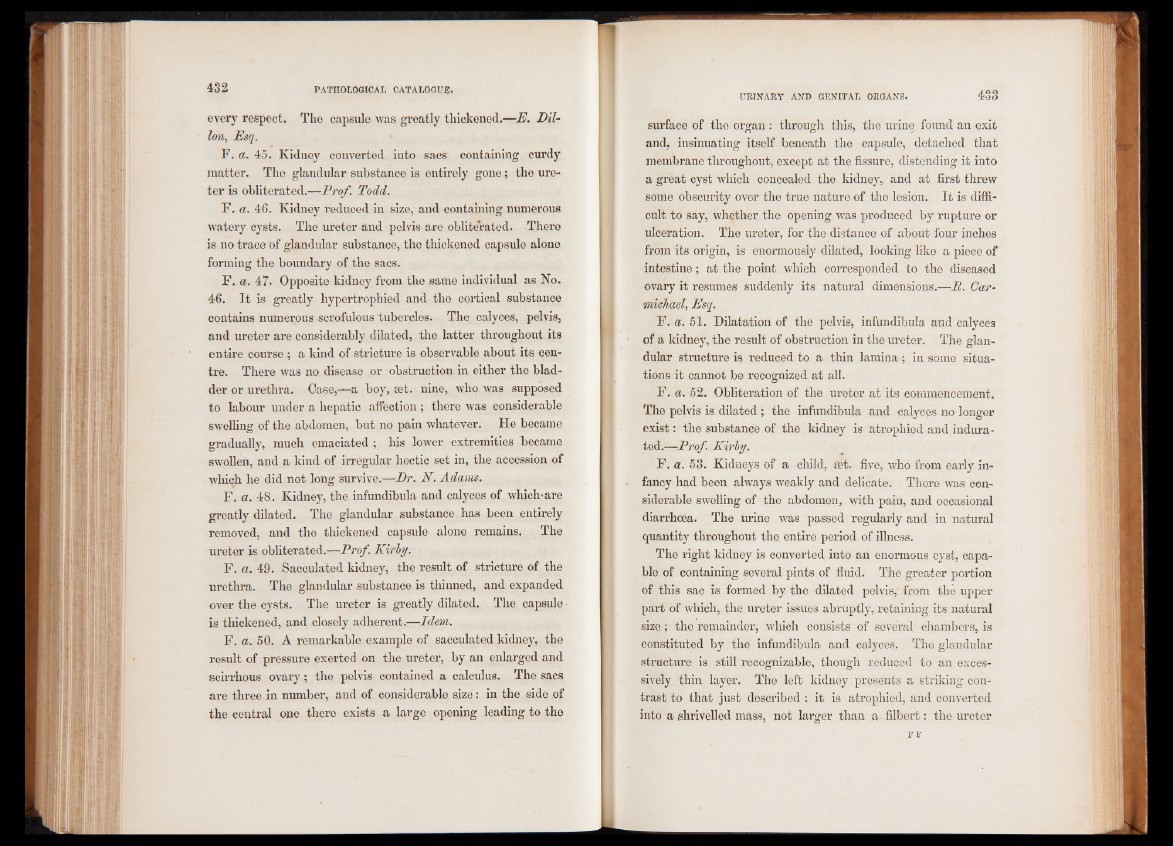
every respect. The capsule was greatly thickened.—E. Dillon,,
Esq.
F. a. 45. Kidney converted into sacs containing curdy
matter. The glandular substance is entirely gone; the ureter
is obliterated.—Prof. Todd.
F. a. 46. Kidney reduced in size, and containing numerous
watery cysts. The ureter and pelvis are obliterated. There
is no trace of glandular substance, the thickened capsule alone
forming the boundary of the sacs.
F. a. 47- Opposite kidney from the same individual as No.
46. It is greatly hypertrophied and the cortical substance
contains numerous scrofulous tubercles. The calyces, pelvis,
and ureter are considerably dilated, the latter throughout its
entire course; a kind of stricture is observable about its centre.
There was no disease or obstruction in either the bladder
or urethra. Case,—a boy, set. nine, who was supposed
to labour under a hepatic affection ; there was considerable
swelling of the abdomen, but no pain whatever. He became
gradually, much emaciated ; his lower extremities became
swollen, and a kind of irregular hectic set in, the accession of
which he did not long survive.—Dr. N. Adams.
F. a. 48. Kidney, the infundibula and calyces of which*are
greatly dilated. The glandular substance has been entirely
removed, and the thickened capsule alone remains. The
ureter is obliterated.-—Prof. Kirby.
F. a. 49. Sacculated kidney, the result of stricture of the
urethra. The glandular substance is thinned, and expanded
over the cysts. The ureter is greatly dilated. The capsule
is thickened, and closely adherent.—Idem.
F. a. 50. A remarkable example of sacculated kidney, the
result of pressure exerted on the ureter, by an enlarged and
scirrhous ovary; the pelvis contained a calculus. The sacs
are three in number, and of considerable size: in the side of
the central one there exists a large opening leading to the
surface of the organ: through this, the urine, found an exit
and, insinuating itself beneath the capsule, detached that
membrane throughout, except at the fissure, distending it into
a great cyst which concealed the kidney, and at first threw
some obscurity over the true nature of the lesion. It is difficult
to say, whether the opening was produced by rupture or
ulceration. The ureter, for the distance of about four inches
from its origin, is enormously dilated, looking like a piece of
intestine; at the point which corresponded to the diseased
ovary it resumes suddenly its natural dimensions.—^. Carmichael,
Esq.
F. a. 51. Dilatation of the pelvis, infundibula and calyces
of a kidney, the result of obstruction in the ureter. The glandular
structure is reduced to a thin lamina; in some situations
it cannot be recognized at all.
F. a. 52. Obliteration of the ureter at its commencement.
The pelvis is dilated; the infundibula and calyces no longer
exist: the substance of the kidney is atrophied and indurated.—
Prof. Kirby.
F. a. 53. Kidneys of a child, mt. five, who from early infancy
had been always weakly and delicate. There was considerable
swelling of the abdomen, with pain, and occasional
diarrhoea. The urine was passed regularly and in natural
quantity throughout the entire period of illness.
The right kidney is converted into an enormous cyst, capable
of containing several pints of fluid. The greater portion
of this sac is formed by the dilated pelvis, from the upper
part of which, the ureter issues abruptly, retaining its natural
size ; the remainder, which consists of several chambers, is
constituted by the infundibula and calyces. The glandular
structure is still recognizable, though reduced to an excessively
thin layer. The left kidney presents a striking contrast
to that just described : it is atrophied, and converted
into a shrivelled mass, not larger than a filbert: the ureter